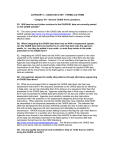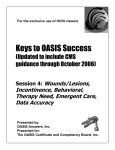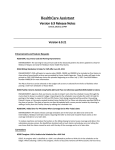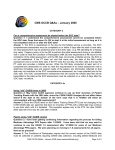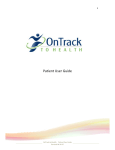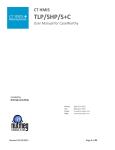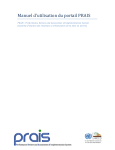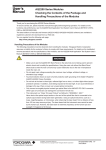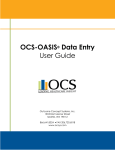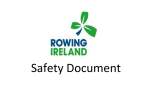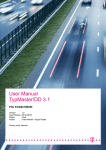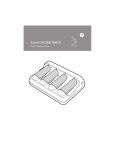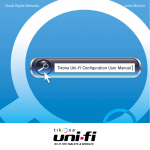Download NOVEMBER 2002 SATELLITE BROADCAST QUESTIONS
Transcript
NOVEMBER 2002 SATELLITE BROADCAST QUESTIONS December 2002 Changes Q1. Please clarify -- How will an agency be reimbursed after 12/16/02 for a Medicare FFS one-visit only patient? A1. For reimbursement, an agency must encode and transmit OASIS SOC data so that a HIPPS code can be generated. Because assessments with reason for assessment (RFA) 2 (found at M0100) will not be accepted by the state system, a SOC comprehensive assessment with OASIS and RFA 1 will need to be performed, and the appropriate data submitted to the state. Agency clinical documentation should indicate that no additional visits occurred after the SOC assessment. Based on current repository data, such events occur relatively infrequently. Q2. For a one-visit Medicare PPS patient, am I correct that RFA 1 is the appropriate response for M0100? Is it data entered? Is it transmitted? Is a discharge OASIS completed? A2. You are correct that RFA 1 is the appropriate response on M0100 for a one-visit Medicare PPS patient. The OASIS data should be encoded (data entered) to generate a HIPPS code and transmitted to the state system. No discharge assessment is required, as the patient receives only one visit. Agency clinical documentation should note that no further visits occurred. Q3. If an OASIS DC assessment (RFA 10 found at M0100) does not have to be completed (if only one visit occurred), how will the patient be closed out from the state OASIS system? A3. The patient will not be closed out from the system, and the record will continue to exist on the state database. If the patient is admitted again, a warning message will be generated, but this will not prevent the new record from being transmitted. A mechanism to close out this record by the OASIS system is being investigated. Q4. Please clarify -- Must RFA 2 and 10 be completed, but the data not submitted? Or is OASIS not completed for RFA 2 and 10? A4. All adult, nonmaternity patients receiving skilled care from the Medicare-certified agency must receive a comprehensive assessment at specified time points. The patient who receives only one skilled visit from the HHA must receive a comprehensive assessment, but OASIS data are not required to be collected (or transmitted). An agency may use a comprehensive assessment clinical documentation of its own choosing for this purpose. If the patient is a Medicare FFS patient for whom reimbursement will be requested, please refer to the exception described above in Question 1 (noting that OASIS data must be collected and transmitted in this circumstance). Note that RFA 10 did not represent an assessment but was a 'housekeeping' mechanism to close out the record on the state system. This 'housekeeping' mechanism will not be completed in the future. Q5. Can you clarify the time from OMB approval to the effective date of the changes? A5. The final OMB approval notice was effective January 22, 2003 for the reduced burden OASIS. Agencies have a choice to implement the reduced burden OASIS now 1 02/11/03 or wait until the fall; however agencies are required to implement the reduced burden OASIS by October 1, 2003. Q6. Can the Patient Tracking Sheet be combined with another form such as the agency's referral form? A6. The agency may choose to use the Patient Tracking Sheet as any other clinical documentation, integrating additional items as desired. If the agency typically collects other items at SOC and updates them only as necessary during the episode of care, these items might be good choices to integrate with the other Tracking Sheet items. The patient's telephone number might be an example of such an item. Q7. Is M0160 (Financial Factors) being eliminated? If so, does this mean that this item was not weighted heavily in the risk adjustment formulas? It seems to me that financial factors would seriously affect outcomes. A7. M0160 was required to be collected since OASIS was implemented, but the responses to this item never have been transmitted to the state. Because the data have never been transmitted, there was no way that they could enter into the data analysis and risk adjustment processes. Therefore, a CMS decision was made to eliminate the item. Eliminating the item from OASIS does not mean it is not important information to consider in care planning; agencies may choose to include information about financial factors in their agency-level comprehensive assessment. Q8. Please explain again the skip patterns related to pressure ulcers and stasis ulcers for M0460, M0478, M0488, and M0530. What do you fill in and what do you skip? Q8. The skip patterns are modified only for the follow-up/recertification time points (RFAs 4 and 5), due to the changes in the required data items for those assessments. There are no changes to the skip patterns associated with these items for RFAs 1, 3, 6, 7, 8, and 9. At the recertification or other follow-up time points, M0460 can be skipped if the patient has no pressure ulcer, M0476 can be skipped if the patient has no stasis ulcer, M0488 can be skipped if the patient has no surgical wound, and M0530 can be skipped if the patient has no urinary incontinence or has a urinary catheter. In designing their clinical documentation for these time points, agencies should pay very close attention to these skip patterns. Q9. Am I correct that the RFA 4 and RFA 5 OASIS will be 23 PPS items? A9. No. The OASIS requirements for RFA 4 and 5 (Follow-up and Other Follow-up) consist of 26 items -- the 23 PPS items plus M0080, M0090, and M0100, plus all other agency -determined components of the comprehensive assessment needed to plan patient care for the subsequent episode. The required OASIS data for RFAs 4 and 5 should be incorporated into the agency comprehensive assessment, as well as, meeting the clinical record requirements. A comprehensive patient assessment still is required at these time points, but the agency must encode and submit only the specific 26 items noted. The agency should determine what additional components are needed to plan patient care for the subsequent episode, in addition to the 26 OASIS items. A sample comprehensive assessment using the reduced burden OASIS is found in Appendix C in Part I of the OASIS User’s Manual, revised December 2002 found on the CMS website at: http://www.cms.hhs.gov/oasis/usermanu.asp. 2 02/11/03 Data Entry/Transmission Questions Q10. I understand that records will need to be manipulated in HAVEN 5.1 as well as HAVEN 6.0. These are not compatible to install together on the same computer. Will the **.mdb files be interchangeable between the two versions? Can you give any tips to help agencies deal with this? A10. HAVEN 5.1 and 6.0 are not compatible when installed to separate directories on the same computer. This refers to the version of the HAVEN program rather than the records stored within the program. Once you have upgraded to HAVEN version 6.0 and log into HAVEN for the first time, a patch is applied to the database. Therefore, if you wish to have access to HAVEN 5.1, you should make a copy of the database (hha.mdb) and the archive files (**.ark) prior to upgrading. HAVEN 5.1 can be installed to a different pc that has not been upgraded to HAVEN 6.0 and these copied files can then be used with the 5.1 version. Q11. Can you clarify what changes an agency can make between 12/09 and 12/16? I am unclear about what the "transition window" entails. A11. OASIS Reduced Burden implementation date is based on the M0090 (Completion Date) of the assessment. If the M0090 date is prior to December 16, 2002 then the record must be encoded using the 1.20 data specifications. For these reasons, it was strongly recommended that agencies not upgrade existing software to accommodate OASIS Reduced Burden (1.30 Data Specifications) until December 16, 2002. Any records encoded using 1.30 data specifications with a M0090 date prior to December 16, 2002 would be rejected when submitted to the state OASIS system. If this rejection occurred, the assessments should be re-encoded using the data specification set 1.20 and submit. Q12. Our agency uses HAVEN software to encode OASIS data. In October 2001, the ICD-9-CM codes changed, and they changed again in October 2002. The HAVEN database has not changed. Will HAVEN 6.0 include a current ICD-9-CM database or the capability to update the existing one? A12. The HAVEN version 6.0 software included an update to the ICD-9-CM database. The list contains current ICD-9 codes as of Fall 2002. Survey Questions Q13. In regard to the branch identification coding, what is the definition of a "branch?" Is it a separate address? A13. The definition of a "branch" is found in the Medicare home health regulations at 42 CFR484.2. According to the regulation, a "branch office is a location or site from which a home health agency provides services within a portion of the total geographic area served by the parent agency. The branch office is part of the home health agency and is located sufficiently close to share administration, supervision, and services in a manner that renders it unnecessary for the branch independently to meet the conditions of participation as a home health agency." The State Operations Manual (SOM), at 3 02/11/03 Section 2182.2, has guidelines for surveyors to utilize when making the determination as to whether an HHA location may be approved as a branch. Q14. What time frame should the surveyor utilize for the Submission Statistics by Agency Report and the Error Summary Report by HHA in the pre-survey activities? A14. The Submission Statistics by Agency Report and the Error Summary Report by HHA each will be reviewed for the most recent 6-month period. Note that this interval is specified on the Training Worksheet included as a handout for the broadcast. Q15. If a patient received emergent care for a wound infection or fall, how can a home visit be made if the patient is no longer on service? A15. If the agency has any patients listed on the Adverse Event Outcome Report, then a home visit should be made to a patient at risk of such an adverse event (not necessarily to a specific patient listed on the patient listing report). You are correct that these patients may no longer be on service. A patient at risk for emergent care for wound infection is a current patient who has a wound. A patient at risk for emergent care caused by an injury due to a fall or accident at home would be a current patient who has difficulty ambulating or transferring, who has a history of falls, who has a diagnosis of arthritis or CVA, who has visual impairment, or who has cognitive impairment. Q16. Educational and motivational research all teach that positive reinforcement is the best way to motivate positive change. Since positive quality change is the purpose of OBQI, and the survey process discussion focused on "errors," "investigation," and "deficiencies," how will CMS change the CoPs or survey process to motivate positive change rather than anxiety over quality improvement? A16. Your question is interesting, and we support the concept of agencies' utilizing the concepts of continuous quality improvement to increase the positive impacts of their care on their patients. The survey process, however, has a somewhat different focus -namely that of monitoring individual agency compliance with the Conditions of Participation (CoP). The CoP might be considered minimum performance standards that an agency must meet to participate in the Medicare home health program, while a quality improvement philosophy encourages an agency to assume its own responsibility for having an increasingly positive impact on patients. We have created a new survey process that is more outcome-oriented, meaning that agencies who are extreme outliers in their outcome results will receive more intensive scrutiny in the survey process. This has been an intention of CMS' shift toward an outcome orientation over the past several years. We are giving agencies both more responsibility and accountability, with a great deal of flexibility in how they provide care -- while we simultaneously meet our responsibility of ensuring that the agency providing care meets Medicare beneficiaries meets at least minimum requirements. Q17. How were the particular outcomes from the adverse event outcome report and the OBQI report selected for survey focus? A17. Several factors were considered in the selection of these outcomes, including input from home health clinicians and researchers familiar with home health. In addition, we solicited the input of the project's technical expert panel, which consisted primarily of surveyors. The criteria used for selection included: a) the frequency with which the outcomes occurred; b) the frequency with which agencies in the national demonstration selected the outcomes to target for OBQM or OBQI activities; c) clinical relevance of the 4 02/11/03 outcome; and d) outcomes that are strong indicators of potential health care delivery problems (e.g., medication errors, falls). The specific thresholds were established through review of national repository data. Q18. Why is there such an emphasis on functional outcomes in the 10 OBQI outcomes selected for survey focus? A18. Many important reasons exist for the emphasis on functional outcomes, and they all have to do with helping to individual remain able to live as independently as possible. Nearly all of us prefer to live independently in our own homes rather than needing to go to a nursing facility where we would have to rely on others to care for us. Let me identify the three primary reasons that we are emphasizing functional outcomes: 1) The home care patient lives (more or less) independently within a unique environment that is his/her home, and the home care services are delivered in that environment. Any changes in the patient's health status directly affect the patient's ability to perform selfcare and home management skills. For example, changes in the patient's physiologic outcomes (e.g., those related to their heart or circulation or lungs or neurologic status or muscles or bones or mental status, etc.) are all likely to affect functional status, which in turn impacts the patient's ability to remain independent and perform self-care and home management. When your heart isn't pumping right or you're having trouble breathing or you can't walk or move without assistance, you're going to have problems with independence. 2) The nature of home care itself dictates an emphasis on functional status. A multidisciplinary approach to patient care delivery typically calls for goals of improving or maintaining the patient's health status so that he/she may be more independent in selfcare and home management. Most members of the home health care team, including nurses, physical and occupational therapists, address functional health patterns and problems. 3) We have learned that functional outcome measures tend to be somewhat objective measures of health status and are generally valid, reliable, and sensitive to variation among and between patients and (when aggregated) home health agencies. General OASIS Questions Q19. Are home health agencies (HHAs) required to submit OASIS data for Medicare managed care patients? What about Medicaid patients? A19. OASIS data from all assessments for Medicare and Medicaid patients receiving skilled services must be submitted to the OASIS state system. This means that any patient for whom OASIS item M0150 (Current Payment Sources) is answered with one of the following responses must have their data encoded and submitted: Response 1 - Medicare (traditional fee-for-service) Response 2 - Medicare (HMO/managed care) Response 3 - Medicaid (traditional fee-for-service) Response 4 - Medicaid (HMO/managed care). This includes Medicare HMO, Medicare managed care patients, and those patients for whom Medicare/Medicaid is a secondary payer. Beginning this winter, CMS is conducting a Medicare Preferred Provider Organization (PPO) demonstration in several states. If you have a patient who is participating in this demonstration, please note the payment source with Response 2 (Medicare HMO/managed care) to M0150. 5 02/11/03 Q20. Are HHAs required to submit OASIS for personal care only patients? What about private pay patients? Q20. Under Federal regulation, HHAs are not required to submit OASIS data for patients receiving only personal care services. Private pay patients who are receiving skilled care must have comprehensive assessments (with OASIS data collection) conducted at the defined intervals, but these data are not required to be encoded or transmitted. See the Federal Register notice of June 18, 1999 for additional details of the regulation. Q21. When you have a patient receiving personal care only (Medicaid) and you do one skilled visit, do you need to do OASIS for the one visit? A21. According to the comprehensive assessment regulations (see the June 18, 1999 and January 25, 1999 issues of the Federal Register) any patients receiving skilled care must receive a comprehensive assessment at specific time points. The December 2002 changes delete the requirement to collect and transmit OASIS data for this single skilled visit, but the comprehensive assessment requirement continues. (The agency may use whatever comprehensive assessment documentation it chooses for this visit.) Q22. For private pay personal care patients, should OASIS data be collected? A22. For patients receiving only personal care services, the comprehensive assessment regulation (including the collection of OASIS data) does not apply. The comprehensive assessment (with OASIS) is required only for patients receiving skilled services from the agency. Of the patients receiving skilled services, only those whose payer source is Medicare or Medicaid (M0150, responses 1, 2, 3, or 4) must have their data encoded and transmitted to the state. See the January 25, 1999 and and June 18, 1999 issues of the Federal Register for the specific regulatory language. The link to these regulations is found on the CMS OASIS web site at: http://www.cms.hhs.gov/oasis/hhregs.asp. Q23. Do we have to "do OASIS" for Department of Aging patients who are receiving nursing for medi-planner fills? A.23 The first point that must be clarified in this situation is whether the patient is receiving skilled care from the agency. If the patient is receiving skilled care, then a comprehensive assessment (with OASIS data) is required at specific intervals. If the patient is not receiving skilled care, then the comprehensive assessment requirements do not apply. If the patient is determined to be receiving skilled care, then the pay source must be evaluated to determine whether the OASIS data must be transmitted to the state. If the pay source is not Medicare or Medicaid, then OASIS data need not be encoded or transmitted to the State agency. Depending on specific state nurse practice acts, medication management may be considered a skilled service in that state and the OASIS would be required to be collected, encoded, and submitted. Q24. Can an RN perform the SOC comprehensive assessment for a PT -only case? A24. An agency may choose to have nursing perform the SOC comprehensive assessment for a PT-only case. In this situation, the nurse must complete the comprehensive assessment no later than 5 calendar days after the start of care date. The comprehensive assessment regulation published in the January 25, 1999 Federal Register notes that therapists may perform all assessments in therapy-only cases. 6 02/11/03 Q25. Why do you have to have two separate, different assessments with OASIS for SOC -- one for nursing and one for therapy? A25. Each agency can make many of its own decisions about the assessment processes and clinical documentation -- for the SOC comprehensive assessment and for other assessments. At one end of a continuum, an agency may choose to utilize a single "discipline-neutral" assessment form that incorporates all comprehensive assessment components and all OASIS items that apply to any assessment point (i.e., SOC/ROC, follow-up, transfer to an inpatient facility, discharge). At the other end of the same continuum, another agency may choose to incorporate discipline-specific asses sment forms for each unique assessment point into its processes. These decisions are made by each agency individually. Chapter 7 of the OASIS Implementation Manual discusses the principles to be followed as an agency makes decisions about documentation (e.g., discipline-neutral vs. discipline-specific; single vs. multiple time points) that support the agency assessment policies. There is not a specific regulation indicating that more than one discipline must collect OASIS data at a specific time point. Q26. What about other proposed changes to OASIS -- what happened to them? I'm referring to dropping the requirement for OASIS data collection for private insurance patients or extending the lock period? A26. There have been a variety of modifications suggested to the current OASIS requirements by several groups. Only the changes presented as part of the December 2002 reduced burden proposal are being implemented at this time. Other suggested modifications are being reviewed to determine their appropriateness for the overall program objectives of the Medicare home health benefit or for the quality of care oversight necessary for certified home health agencies. In addition, the relative ease of making changes must be considered. For example, some proposed changes would require changes in the Conditions of Participation, which are more difficult to implement. OASIS Item Questions Q27. If a patient goes for emergent care and is then admitted to the hospital, what is the appropriate response to M0830? A27. As noted in the item-by-item tips for M0830 (Attachment B to Chapter 8 of the OASIS Implementation Manual), current events must be included in the response to this item. Therefore, the patient who goes for emergent care and is admitted to the hospital did receive emergent care. The appropriate response to M0830 would be 1, 2, or 3, depending on where the patient received the emergent care. Q28. If a patient has a pressure ulcer or a stasis ulcer and receives a skin graft in the hospital, how is this recorded on the ROC assessment? Does the skin graft change the ulcer to a surgical wound or is the ulcer described as what it was prior to the skin graft? What if the ulcer is a diabetic ulcer -- is the answer the same? A28 -- In the first two situations you describe, the skin graft is a treatment approach to an underlying problem -- that of the pressure or stasis ulcer. Therefore, the original pressure ulcer or stasis ulcer remains -- now being treated by a skin graft. Note that if the patient himself/herself is the donor for the skin graft, then the donor site is a new lesion that has been created by a surgical procedure, so it would be considered a surgical wound. Similarly, a diabetic patient with a chronic ulcer of the skin continues to have such an ulcer when the skin graft treatment approach is utilized. 7 02/11/03 Q29. The OASIS Implementation Manual specifically states that if a muscle flap is performed on a pressure ulcer, the wound then is considered a surgical wound, not a pressure ulcer. Has this changed? A29. No, this remains appropriate guidance. The muscle flap actually replaces the pressure ulcer -- so the wound then becomes a surgical wound. OASIS-Based Reports Q30. If risk adjustment calculations are changed, how do we know that our agency's outcomes from the next reports are comparable to the ones we got last year? We update the statistical models used for risk adjustment calculations on a yearly basis to make sure they are current with any changes in the relationships between patient risk factors and outcomes, in addition to continuously improving their effectiveness in predicting patient outcomes. These updates are part of CMS' efforts to assure that outcome comparisons between home health agencies are appropriate and statistically valid. The updates rarely result in noticeably different results for individual agencies, but if the models were not updated they would tend to become less effective (in taking patient characteristics into account) over a period of several years. In 2003 a new OBQI outcome report will be made available, which will provide a comparison of current outcomes to those from the prior year for the same agency, as well as a comparison with risk-adjusted national outcome rates. When this report becomes available, the comparisons between the agency's current outcomes and the prior year's performance will be risk adjusted using the most current statistical models, providing a comparison that "factors out" any changes in patient case mix that may occur from one year to the next. Q31. Is it possible to obtain the risk adjustment models from the web page? There is a technical paper on the CMS web page describing the risk adjustment methodology in detail, including illustrative risk models. The article is found at: (http://www.cms.hhs.gov/providers/hha/. Comprehensive documentation of all the statistical models used in the production of the risk-adjusted outcome report is currently being prepared and will be published by CMS at a later date. 8 02/11/03








